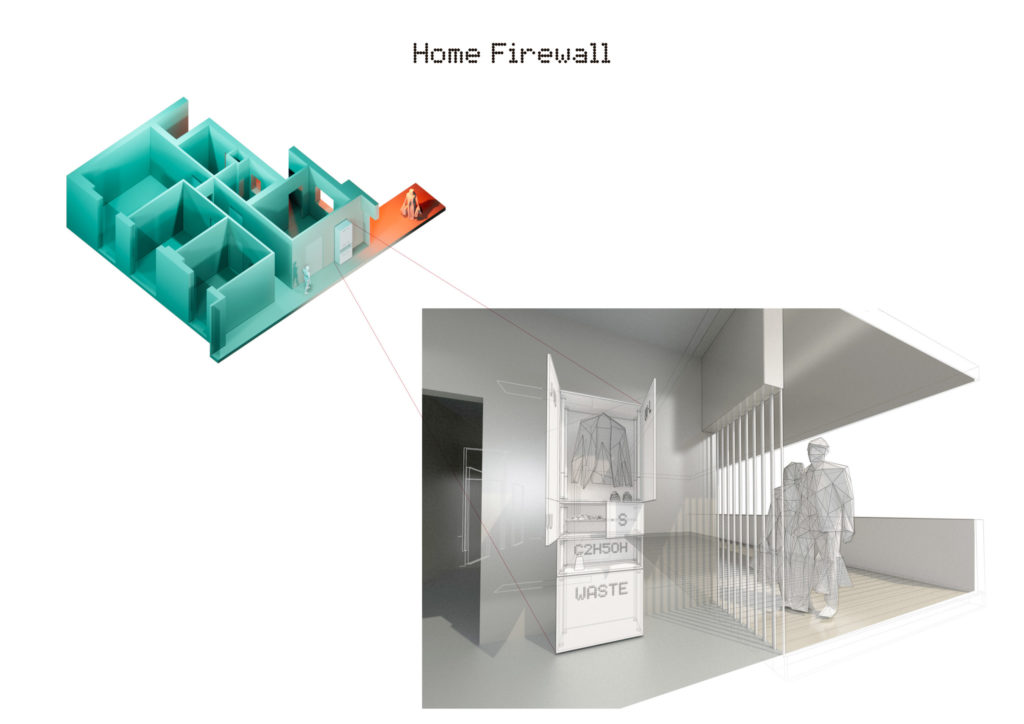
Design Challenge
#3: How might we learn from COVID-19 to reimagine our future for life, work, learning and play?
Project Description
In computing, a firewall typically establishes a barrier between a trusted internal network and untrusted external network, such as the Internet. The project Home Firewall proposes a physical device, a sanitizing furniture, which serves as an entry zone in the house to protect the flow of undesired germs from the city into the sacred domestic space. Using a selection of sterilization technologies, the modular furniture protect the dwellers as they leave and re-enter their homes. The proposed location of the furniture within the house is the immediacy of the entry door, to minimize the risks of contamination inside the house.
The main technology is the germicidal UVC light which can effectively deactivate hazardous germs. Within tight modules with reflective interiors, the light can reach.
Criteria #1: Value
A real challenge experienced in the pandemic is the struggle to manage the time-consuming sanitation ritual when leaving and coming back home. Where do take new and discard used facemasks? What should I do with the trash to protect my neighbour? How can I clean the grocery bags before bringing it to the kitchen?
Home Firewall solves this domestic struggle by managing the cleansing rituals in the proximity of the door, with a set of modular cabinets that deactivate dangerous germs in before coming into the house. A simpler sanitation process means that people will get it done protecting the family and community.
Criteria #2: Inspiration
The inspiration of this project is the concept of firewall in the world of computing. Firewall is defined as a barrier between a trusted internal network and untrusted external network, such as the Internet. The translation of this concept to the domestic environment is envisioned as a cabinet system that can control the flow of germs into and out of the house. UVC technology, which has been proven to be an effective germ deactivation agent, in addition to existing hand sanitation gels and tissues are provided in a sleek furniture system.
Criteria #3: Impact
The project benefits the family and the community. A simple and effective sanitation ritual significantly lowers the risk of spread of germs and diseases. The minimalism of the design means that users can quickly understand the operation and that will easily fit to user taste. The simplicity of the concept makes the production affordable and feasible for the local industry. And, with most households being protected, more secured we all are.
Criteria #4: Timeliness
The project can be quickly manufactured in Singapore with existing woodworking skills, material stock and infrastructure. In addition, the germicide effectiveness of the design can be validated within the local academic and research organizations.
Within a first month, the project will be developed and prototyped, studying the range of household needs. The second month, the germicidal effectiveness will be tested in lab experiments. The planning for the ramp up of the production will be develop during the third month. The product will be available in the market in the fourth month.
Criteria #5: Systems Thinking
Protection from germs outside home are currently supported by social distancing, personal protection equipment and frequent handwashing policies and recommendations. However, during and after the pandemic, leaving and re-entering home became a complicated ritual where multiple things need to be overlooked carefully in a small space and time. A small mistake in this process can undermine all other efforts. The project Home Firewall fills this gap, making the process of leaving and coming back home simple and safe, complementing and enhancing existing sanitation mechanisms.


